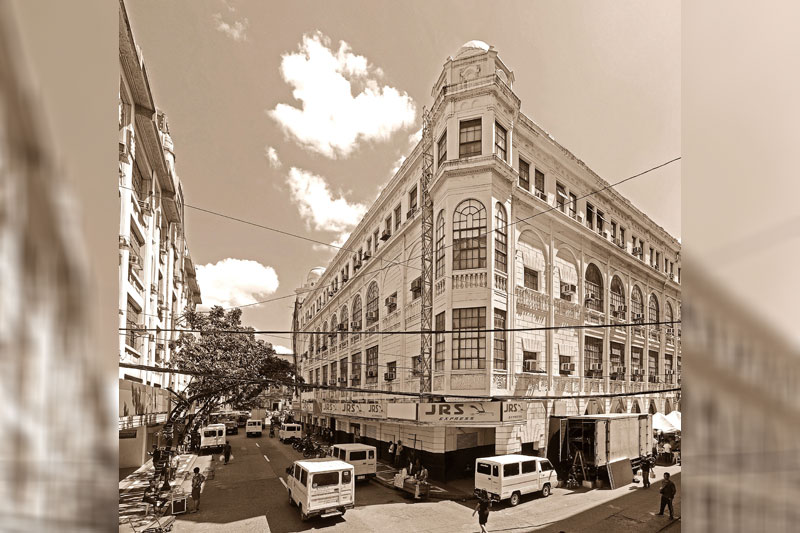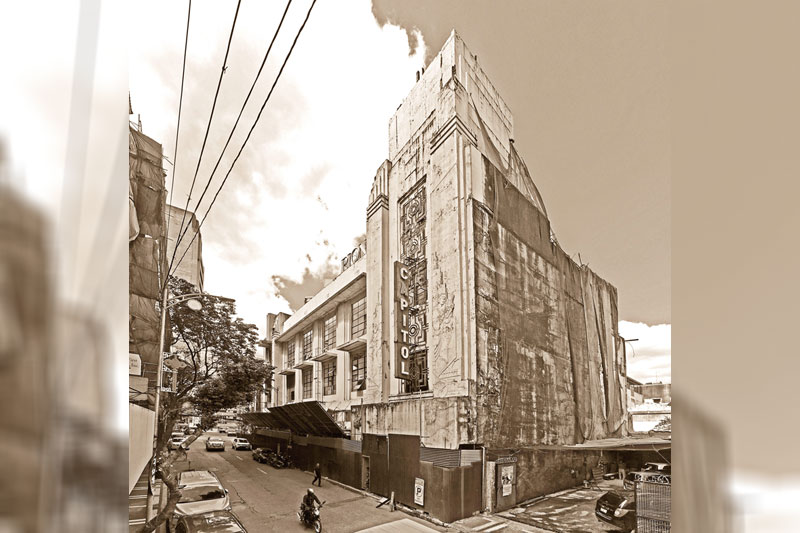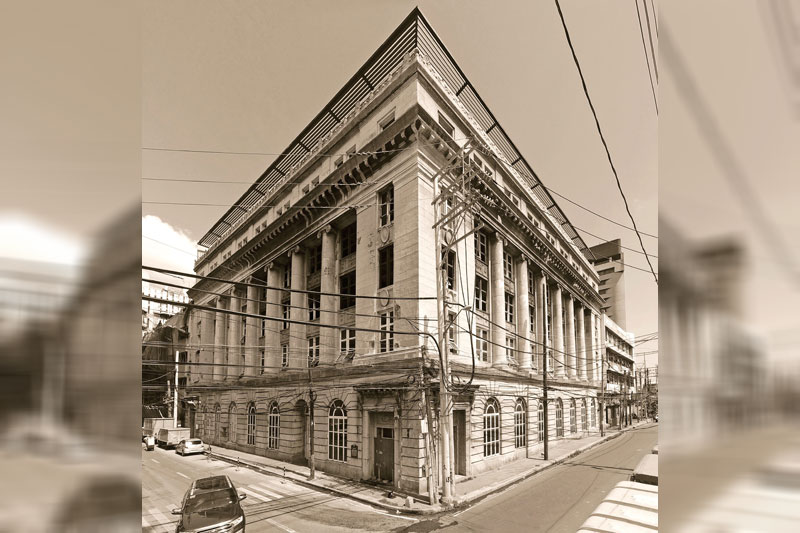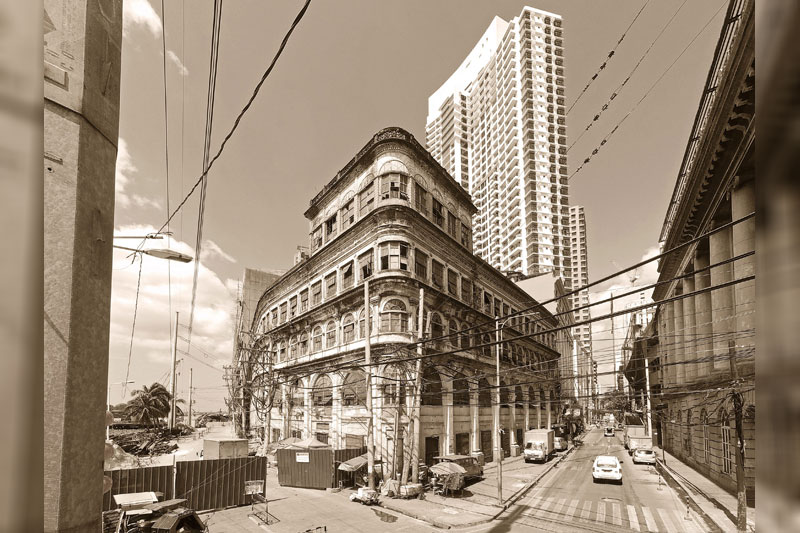Escolta in black and white


A month before the big quarantine I had the chance to visit Escolta, Manila’s old premier shopping street. I took images of seven key heritage buildings that still stand in the district. I processed the images in black and white to highlight the heritage and architectural value of these structures.
We start at the Sta. Cruz end of the storied street and work our way west, stopping at five buildings. We end a little past the actual Escolta, where a tandem of elegant buildings anchor the river end of Juan Luna Street.
The first united building
This Escolta landmark, formerly known as the Perez-Samanillo Building, was designed by Andres Luna de San Pedro, son of painter Juan Luna, and completed in 1928. It was known for Berg’s Department Store and housed the production offices of Dolphy and Nora Aunor in the ‘70s. Today the FUB hosts millennial enterprises, with boutique design studios and the headquarters of the Heritage Conservation Society on the upper floors. The current owners, the Syliantengs, support the revival of the district and run a community museum on the mezzanine.

Regina building
Across from the FUB is another creation by the same architect. Completed in 1934 this stately commercial building was first owned by the Roxas family. Subsequently, Don Jose Leoncio de Leon bought the structure and named it after his wife Regina. Designed in a mix of Neoclassical and Beaux Arts styles, it is a large structure that reaches all the way to the Pasig River.

Natividad building
A street down is the well-conserved Natividad Building. It was completed in 1920 from a design by Spanish architect Fernando dela Cantera Blondeau. The building’s Beaux Arts style facades are Simply gorgeous. The building also housed the Philippine Insurance Agency, and on the first floor the Philippine Educational Company (PECO), the National Bookstore of its day. Now called the TEOFF Center, a furniture store anchors its ground level.

Calvo building
Midway down Escolta the street opens wider for about a block. Here we find the Calvo Building, another revival style building. It was designed by Fernando H. Ocampo and completed in 1938. Its ornate architectural ornamentation is fascinating. Like the FUB, it has a museum of Escolta-related photos, memorabilia and assorted ephemera of the street. The building was the birthplace of pioneer radio station DZBB.
Across from the Calvo stood two iconic examples of Filipino architecture. Before the war, Andres Luna de San Pedro built the Crystal Palace, arguably the most beautiful Art Deco building in the country. It had a two-story shopping arcade with a grand atria. Sadly, it did not survive the war. In the 1970s, the Carlos Arguelles-designed modernist PNB skyscraper was built on the same site. It did not survive recent pressures for commercial redevelopment.

Capitol theater
Another Art Deco delight was built about the same time as the Calvo. The Art Deco Capitol Theater was designed by Juan Nakpil, who would eventually honored as a National Artist for Architecture. The landmark is distinguished by a cube-topped tower with sculptural reliefs by Italian sculptor Francesco Riccardo Monti. The 800-seat cinema boasted a balcony and loge sections above its orchestra floor. The main structure has been gutted for an eventual new development. The façade, hopefully, will be conserved.
We end this short tour just a bit past the Escolta across the Jones Bridge to the corner of the Muelle de Industria and Juan Luna streets.

FNCB building
Now known as the Juan Luna E-Services Building, this collonaded Neo-classic structure was home to the First National City Bank of New York. The structure was designed by the American firm of Murphy, McGill and Hamlin. Completed in 1922, it survived the Second World War and served the bank until its successor Citibank moved to Makati. The building has since been adaptively re-developed as a BPO office building.

The El Hogar
The El Hogar Filipino Building, along with the FNCB has been the face of Manila’s riverfront in the pre- and post-war years. The building was designed in the Beaux Arts style by the tandem of Ramon Irureta-Goyeana and Francisco Perez-Muñoz. The building was completed in 1914. It was a wedding gift of the owner Don Antonio Melan to his wife Margarita Zobel de Ayala. From the building, Melan ran the Sociedad El Hogar Filipino, a finance company. Trading firms of the era like Smith, Bell &Company, sought this premier address.
These two buildings, as well as the whole Escolta, have been favorite locations for commercials and feature films. There are few streets or districts in the metropolis with enough extant heritage buildings. There are not many that can tell as many stories of the past, and provide Manilans with a glimpse of the cosmopolitan center that Manila once was.
All is not lost however, as the Escolta district is undergoing a renaissance. New uses and a new generation of patrons are coming to discover Escolta and its potential beyond its facades. After this time of crisis, I do hope Manila’s energetic new mayor continues what he started, and make Escolta one of the key sites of his renewal efforts without the loss of any more heritage masterpieces as shown here.



















